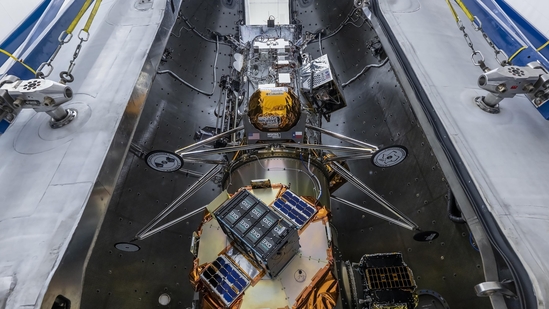NASA’s Lunar Trailblazer and IM-2 Mission

- 03 Mar 2025
In News:
NASA launched the Lunar Trailblazer spacecraft aboard a SpaceX Falcon 9 rocket from Kennedy Space Center to enhance understanding of water distribution on the Moon—crucial for long-term human exploration under the Artemis program.
Lunar Trailblazer Mission:
- Type: Small satellite (orbiter); part of NASA’s Small, Innovative Missions for Planetary Exploration (SIMPLEX) program.
- Developed by: NASA in collaboration with Lockheed Martin.
- Objective:
- Map and analyze the presence of water, particularly in permanently shadowed craters near the Moon’s poles.
- Study the lunar water cycle and evaluate water as a potential resource for future missions.
- Instruments:
- Lunar Thermal Mapper (LTM): Measures surface temperature to track water movement.
- High-resolution Volatiles and Minerals Moon Mapper (HVM3): Detects spectral signatures of water molecules.
- Timeline:
- Fuel-efficient trajectory to reach the Moon in 4 months.
- Mission duration: At least 2 years of mapping operations.
- Significance:
- Supports Artemis program objectives—long-term human presence on the Moon.
- Identifies potential water sources for drinking, fuel, and oxygen.
- Enhances understanding of water on airless planetary bodies and may offer clues to Earth’s water origins.
IM-2 Mission and Intuitive Machines’ Lunar Lander:
- Landing Site:Mons Mouton, near the Moon’s south pole (landing scheduled for March 6).
- Under: NASA’s Commercial Lunar Payload Services (CLPS) and Artemis campaign.
Key Scientific Objectives and Instruments:
- Polar Resources Ice Mining Experiment-1 (PRIME-1):
- TRIDENT Drill: Extracts lunar soil samples.
- MSolo Spectrometer: Detects volatile compounds in samples (e.g., water vapor).
- Laser Retroreflector Array (LRA): Provides a precise, passive reference point for future orbiters using laser ranging.
- Micro Nova Hopper (“Grace”):
- Autonomous drone developed under NASA’s Tipping Point initiative.
- Capable of hopping into shadowed craters to collect and transmit data.
- Nokia Lunar Surface Communications System (LSCS):
- 4G/LTE system for high-definition video, telemetry, and command messaging.
- Supports inter-device connectivity between the lander, rover, and hopper.
Strategic Importance:
- Pioneers in-situ resource utilization (ISRU) demonstrations.
- Tests surface communications and autonomous mobility systems.
- Lays groundwork for sustainable human presence and commercial space infrastructure.
